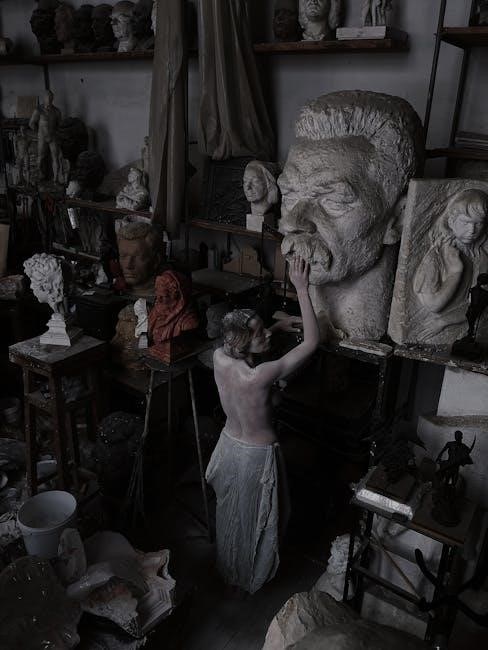Living with Art PDF is an essential guide to enhancing your space and fostering creativity through art appreciation. It explores how art enriches daily life, offering insights into its historical, psychological, and cultural significance while providing practical advice on selecting and displaying art in your home.
1.1 What is Living with Art?
Living with art refers to the practice of integrating art into daily life, transforming spaces into reflections of personal identity and culture. It involves creative expression, fostering emotional connections and enriching environments. Beyond mere decoration, art becomes a medium for storytelling, cultural exchange, and self-reflection. This concept emphasizes the psychological and social benefits of surrounding oneself with meaningful pieces, creating a harmonious blend of aesthetics and functionality. Whether through paintings, sculptures, or digital works, living with art invites individuals to engage deeply with their surroundings, fostering a sense of belonging and inspiration in their homes and communities.
1.2 The Importance of Art in Daily Life
Art plays a vital role in daily life, offering emotional, mental, and cultural enrichment. It serves as a medium for self-expression, fostering creativity and personal growth. Surrounding oneself with art can enhance mood, reduce stress, and create a sense of calm. Beyond individual benefits, art bridges cultural gaps, promoting understanding and unity. It also inspires innovation and critical thinking, contributing to societal progress. By integrating art into daily routines, individuals cultivate a deeper appreciation for beauty and meaning, enriching their lives and the world around them. Thus, art is not just a luxury but a necessity for a fulfilling existence.

The Benefits of Living with Art
Living with art enhances emotional well-being, fosters creativity, and strengthens cultural connections. It creates a harmonious environment, enriching daily life with beauty and inspiration.
2.1 Psychological Benefits of Art
Engaging with art has profound psychological benefits, including reduced stress, improved mood, and enhanced cognitive function. Studies show that exposure to art lowers cortisol levels, fostering relaxation and mental clarity. It also stimulates creativity, encouraging critical thinking and problem-solving skills. Art’s ability to evoke emotions and spark personal connections can uplift spirits and provide a sense of balance in daily life. By creating a calming and inspiring environment, art plays a vital role in promoting mental well-being and emotional resilience, making it an essential element for a fulfilling and healthy lifestyle.
2.2 Cultural and Social Benefits of Art
Art serves as a powerful bridge between cultures, fostering understanding and appreciation of diverse traditions. It preserves cultural heritage while encouraging cross-cultural dialogue, enriching societal fabric. Socially, art brings communities together through shared experiences like exhibitions and festivals, creating a sense of belonging. It also inspires empathy and tolerance, often addressing social issues like inequality and injustice. By promoting unity and cultural exchange, art plays a vital role in shaping a harmonious and inclusive society, making it an essential element for cultural and social enrichment.

The History of Art in Everyday Life
Art has long been intertwined with human existence, reflecting cultural values and societal evolution. From ancient pottery to modern installations, art enriches daily life, preserving history and inspiring creativity.
3.1 The Evolution of Art in Homes
The integration of art into homes has evolved significantly over centuries, reflecting cultural shifts and artistic movements. Early periods saw art as decorative elements, such as pottery and tapestries, while the Renaissance emphasized grandeur with paintings and sculptures. The Middle Ages brought religious art into homes, while modern times introduced minimalist and contemporary styles. Digital art has now emerged, allowing for dynamic and interactive pieces. This evolution highlights how art adapts to societal changes, transforming living spaces into reflections of personal identity and cultural heritage. The rise of digital art further blurs the line between tradition and innovation in home decor.
3.2 Historical Movements in Art and Their Impact on Living Spaces
Historical art movements have profoundly shaped how art is integrated into living spaces. The Renaissance emphasized classical symmetry, influencing opulent interiors, while the Industrial Revolution brought mass-produced decorative arts, making art accessible to the masses. Art Nouveau introduced flowing lines and natural motifs, transforming homes into organic spaces. Modernism simplified forms, prioritizing function over ornamentation, and Minimalism stripped spaces to essentials, focusing on clean lines and monochromatic schemes. Each movement reflects cultural values, reshaping interiors to mirror societal ideals. These shifts demonstrate how art movements influence design trends, creating spaces that reflect the spirit of their times and the evolution of human creativity.
Choosing the Right Art for Your Space
Selecting art that resonates with your personal style and enhances your space requires considering size, color, and style. Ensure it complements the room’s ambiance and reflects your identity.
4.1 Understanding Personal Taste in Art
Understanding personal taste in art involves reflecting on what emotionally resonates with you. Consider the styles, themes, and mediums that captivate your imagination and align with your lifestyle. Think about the ambiance you wish to create in your space—whether it’s calm, vibrant, or thought-provoking. Your personal history and experiences also play a role in shaping your preferences. Exploring various art forms and periods can help refine your taste, ensuring the pieces you choose not only beautify your environment but also reflect your unique perspective and personality. This self-awareness is key to curating a meaningful and harmonious art collection.
4.2 How to Select Art That Matches Your Interior Design
Selecting art that complements your interior design requires harmony between the piece and its surroundings. Consider the room’s color palette, furniture style, and overall aesthetic. Choose art that echoes the space’s mood—vibrant for energetic areas, serene for calming environments. Scale is crucial; ensure the artwork fits the wall and furniture proportions. Frame styles should align with the room’s decor, blending seamlessly. Additionally, think about the artwork’s theme and how it interacts with the space’s functionality. By balancing these elements, you create a cohesive visual experience where art enhances the interior design, making the space feel intentional and beautifully curated.
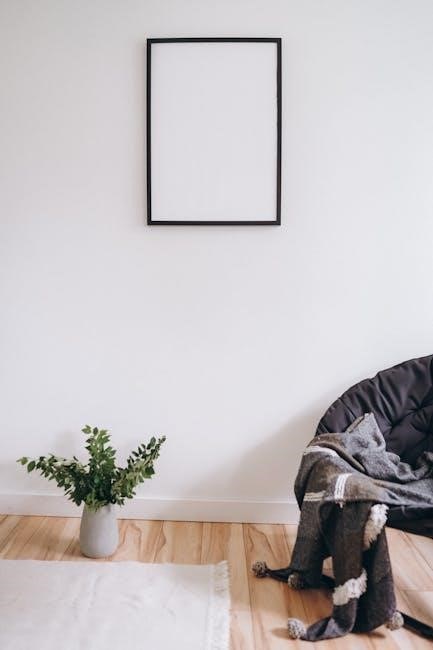
The Psychology of Color in Art
Color profoundly influences emotions and ambiance, shaping perceptions and moods. Warm hues evoke energy, while cool tones create calmness, impacting how spaces are experienced and felt.
5.1 How Colors Influence Emotions
Colors have a profound impact on human emotions, shaping moods and perceptions. Warm tones like red and orange stimulate energy and passion, while cool colors such as blue and green evoke calmness and serenity. Yellow often induces happiness, whereas purple fosters creativity and luxury. These emotional responses are deeply rooted in cultural and personal experiences, making color a powerful tool in art and design. By understanding how colors influence emotions, individuals can strategically use them to create harmonious and emotionally resonant environments, enhancing both personal well-being and the aesthetic appeal of living spaces.
5.2 The Role of Color in Enhancing Room Ambiance
Color plays a crucial role in shaping the ambiance of a room, transforming it into a space that reflects desired moods and atmospheres. Warm, vibrant hues like red and orange can create energetic and inviting environments, while softer tones such as beige and sage green foster tranquility. The strategic use of color can highlight architectural features, unify decor, and even manipulate perceptions of space. By selecting colors that align with personal preferences and the room’s purpose, individuals can craft spaces that inspire relaxation, productivity, or celebration, ultimately enhancing the overall living experience and emotional connection to their surroundings.
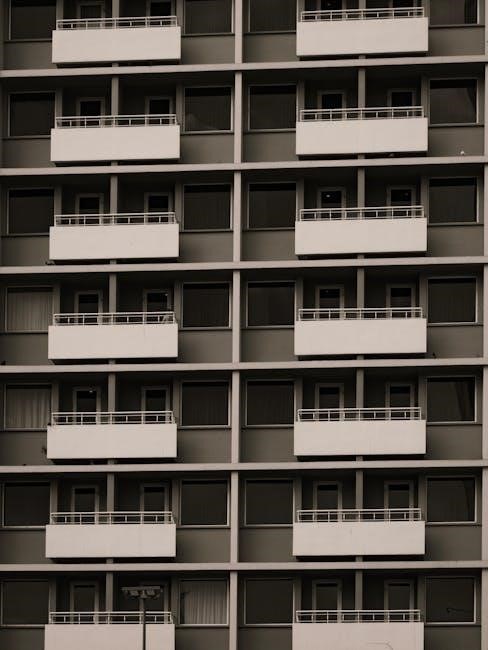
The Digital Age and Living with Art
The digital age has revolutionized how we experience and interact with art, offering new ways to discover, create, and share artistic expressions through technology and online platforms.
6.1 The Rise of Digital Art
Digital art has emerged as a transformative force in the contemporary art world, blending traditional creativity with cutting-edge technology. With the advent of software tools and digital platforms, artists can now create intricate, interactive, and dynamic works that were once unimaginable. From digital paintings to 3D sculptures, this medium allows for unparalleled versatility. The rise of NFTs has further revolutionized digital art, providing artists with new avenues for monetization and authentication. As technology evolves, digital art continues to push boundaries, making it more accessible and immersive for audiences worldwide. This shift is redefining how we experience and engage with art in our daily lives.
6.2 How Technology Has Changed the Way We Experience Art
Technology has revolutionized the way we experience art, making it more accessible and interactive than ever before. Virtual galleries, augmented reality (AR), and digital platforms now allow audiences to engage with art from anywhere in the world. Social media has democratized art appreciation, enabling global conversations and instant sharing of creative works. Additionally, digital tools like 3D scanning and virtual reality (VR) provide immersive experiences, bringing art to life in unprecedented ways. These advancements have not only expanded the reach of art but also redefined how we perceive, interact with, and connect to creative expressions in our daily lives.
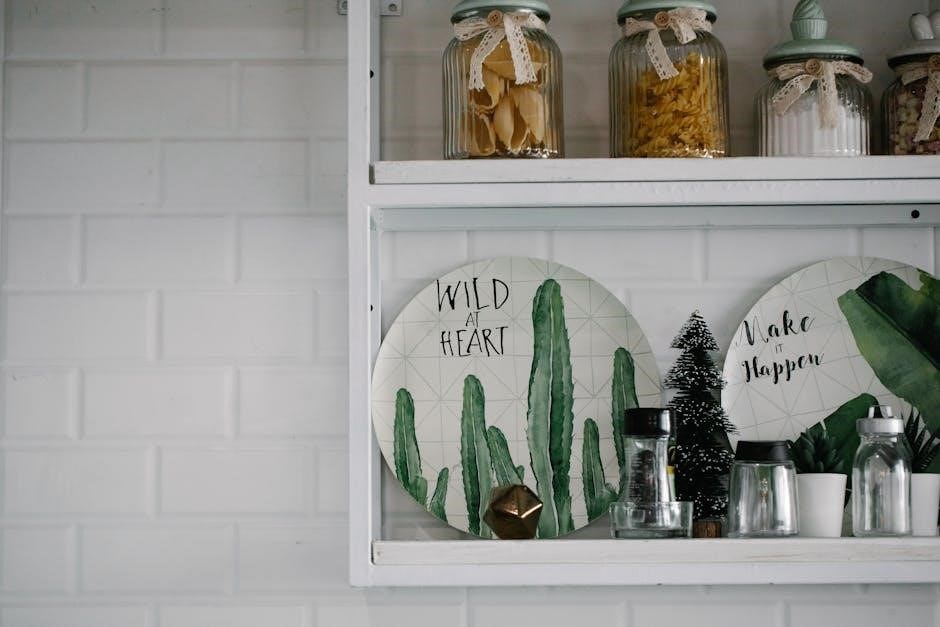
Budget-Friendly Ways to Collect Art
Discover affordable art options, such as prints, emerging artists, and local fairs, to build a meaningful collection without breaking the bank, making art accessible to everyone.
7.1 Affordable Art Options for Beginners
Starting an art collection doesn’t have to be costly. Beginners can explore affordable options like limited edition prints, posters, and works by emerging artists. Local art fairs, student exhibitions, and online marketplaces often feature budget-friendly pieces. Additionally, reproductions of famous artworks can bring elegance to a space without the high price tag. These options allow newcomers to experiment with different styles and discover what resonates with them personally, making the journey of collecting art both enjoyable and accessible. Remember, the goal is to connect with art that speaks to you, regardless of its price.
7.2 Investing in Emerging Artists
Investing in emerging artists offers a unique opportunity to support fresh talent while potentially gaining value over time. These artists often produce innovative and groundbreaking work, making their pieces culturally significant. Their affordability allows collectors to acquire high-quality art without hefty prices. Attend local art shows, galleries, and online platforms to discover up-and-coming artists. Research their background and market trends to make informed decisions. Building a relationship with the artist can also enhance your investment experience. This approach not only enriches your personal art collection but also contributes to the growth of the artistic community, making it a rewarding and impactful choice.
The Impact of Art on Interior Design
Art is a powerful element that can transform a space by setting the tone, creating a focal point, and enhancing the overall ambiance and style.
8.1 Using Art as a Focal Point in a Room
Using art as a focal point in a room creates visual interest and draws attention to a specific area. It reflects the owner’s personality and style, enhancing the space’s ambiance. Strategic placement, such as above a fireplace or sofa, maximizes impact. The size and scale of the artwork should complement the room’s dimensions, ensuring it stands out without overwhelming. Bold colors or unique designs can make the piece a conversation starter, while neutral tones blend seamlessly. By thoughtfully selecting and positioning art, it becomes the centerpiece, tying together the room’s decor and inspiring emotional connections with those who experience it.
8.2 How Art Can Transform a Space
Art has the power to transform a space by evoking emotions, enhancing ambiance, and reflecting personal style. It can turn a mundane room into a vibrant, thought-provoking environment that sparks creativity and fosters well-being. By selecting pieces that resonate with the space’s purpose and design, art creates a sense of identity and harmony. It unifies disparate elements, such as furniture and decor, into a cohesive whole. Whether through bold statements or subtle nuances, art becomes a dynamic force that elevates the atmosphere, making the space not just functional but also deeply personal and inspiring, ultimately enriching the lives of those who inhabit it.
Creating a Personal Art Collection
Creating a personal art collection is a journey of self-expression and discovery. It reflects your tastes, values, and experiences, growing more meaningful as it evolves over time.
9.1 Starting Your Art Collection
Starting your art collection is an exciting journey that begins with defining your interests and budget. Explore galleries, local artists, and online platforms to discover diverse styles. Consider the size, medium, and themes that resonate with you. Begin with affordable pieces, such as prints or emerging artists, to build your foundation. Educate yourself about art movements and trends to make informed decisions. Engage with the art community, attend exhibitions, and seek advice from experts to refine your taste. Every piece you collect tells a story, reflecting your unique perspective and growing into a meaningful, personal art collection over time.
9.2 Curating Art That Reflects Your Personality
Curating art that reflects your personality involves selecting pieces that resonate with your values, experiences, and emotional connections. Start by identifying themes or styles that speak to you, whether modern, abstract, or traditional. Consider how each artwork aligns with your personal journey and cultural background. Mix art forms, such as paintings, sculptures, or photography, to create a unique visual narrative. Display pieces in a way that highlights your individuality, ensuring each item feels intentional and meaningful. This thoughtful approach transforms your space into a reflection of your identity, making it a vibrant and authentic expression of who you are.
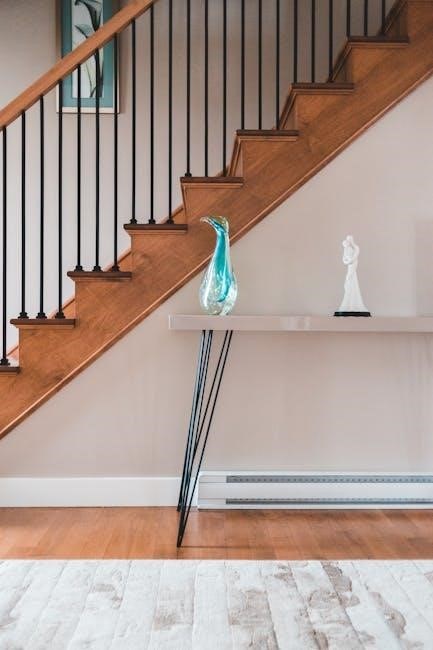
The Role of Art in Emotional Well-Being
Art plays a vital role in emotional well-being by serving as a therapeutic outlet, reducing stress, and fostering mental balance through creative expression and calming visual experiences.
10.1 Art as a Therapeutic Tool
Art has long been recognized as a powerful therapeutic tool, offering individuals a creative outlet to express emotions and process experiences. Through various forms such as painting, drawing, or sculpture, art therapy provides a safe space for self-reflection and healing. It is particularly effective in addressing mental health challenges like anxiety and depression by allowing individuals to communicate feelings that may be difficult to articulate verbally. Studies have shown that engaging in artistic activities can reduce stress levels, improve mood, and enhance overall well-being. This makes art a valuable complement to traditional therapeutic practices, fostering emotional resilience and personal growth.
10.2 How Art Can Improve Mental Health
Art has a profound impact on mental health by providing an outlet for emotional expression and fostering a sense of calm. Engaging with art, whether through creation or appreciation, can reduce stress, anxiety, and depression. It encourages mindfulness, allowing individuals to focus on the present moment and distract from negative thoughts. The process of creating art stimulates the brain’s reward system, releasing endorphins that improve mood and overall well-being. Additionally, art can enhance cognitive function, boost creativity, and provide a sense of accomplishment. For many, living with art becomes a therapeutic practice that promotes resilience and supports mental health management.
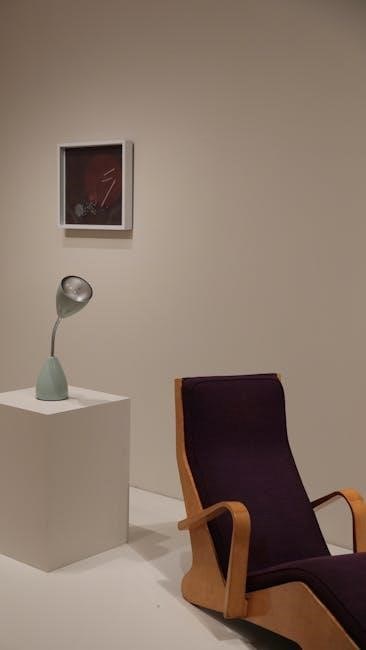
The Future of Art in Home Living
The future of art in home living is digital, interactive, and personalized, blending technology with creative expression to enhance spaces and emotional connections.
11.1 Trends in Home Art Decoration
Current trends in home art decoration emphasize blending technology and tradition, with digital art installations, interactive displays, and sustainable materials gaining popularity. Personalization is key, as homeowners seek pieces that reflect their identities. Minimalism remains influential, but bold, vibrant art is also making a comeback to create focal points. The integration of smart technology, such as LED-lit canvases and augmented reality art, allows for dynamic and evolving spaces. Additionally, there’s a growing interest in eco-friendly art practices, ensuring that decoration aligns with both aesthetic and environmental values. These trends highlight the evolving relationship between art, design, and daily living.
11.2 The Integration of Art and Technology in Future Homes
The integration of art and technology in future homes is revolutionizing how we experience and interact with art. Smart devices and interactive displays now allow for dynamic, ever-changing art installations that adapt to mood or setting. Augmented reality (AR) and virtual reality (VR) are enabling immersive art experiences within living spaces. Additionally, energy-efficient LED displays and digital canvases are becoming popular, blending seamlessly with interior design. Personalization is enhanced through technology, enabling homeowners to curate art collections that reflect their tastes. This fusion of art and technology not only enriches daily life but also redefines the concept of living with art in the digital age.
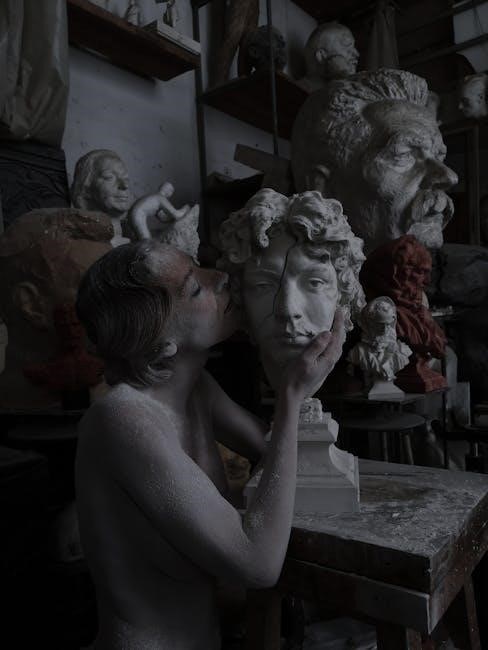
Case Study: Living with Art
A case study explores how a family transformed their home by integrating art, creating a space that reflects their personality and fosters emotional and cultural connections through creative expression.
12.1 Real-Life Examples of Art in Homes
Real-life examples showcase how homeowners have seamlessly integrated art into their living spaces, creating unique and meaningful environments. From modern installations to classic paintings, these examples highlight the emotional and aesthetic impact of art. One homeowner transformed a minimalist apartment by adding vibrant abstract pieces, while another used sculptures to bring warmth to an open-concept living area. These real-world applications demonstrate how art can reflect personal style, spark conversation, and enhance daily life. By sharing such examples, the guide inspires readers to experiment with art in their own homes, proving that art is not just for galleries but for living.
12.2 Success Stories of Art Integration
Success stories of art integration reveal the transformative power of art in homes; A couple in Brooklyn turned their loft into a gallery-like space, featuring local artists’ work, which became a community hub. Another homeowner in London used art to bridge cultural gaps, displaying pieces from global travels. These stories highlight how art fosters connection and identity, showing that successful integration goes beyond aesthetics to create meaningful living environments. They inspire readers to view their homes as canvases for personal expression, proving that art integration can enrich lives and build lasting legacies.
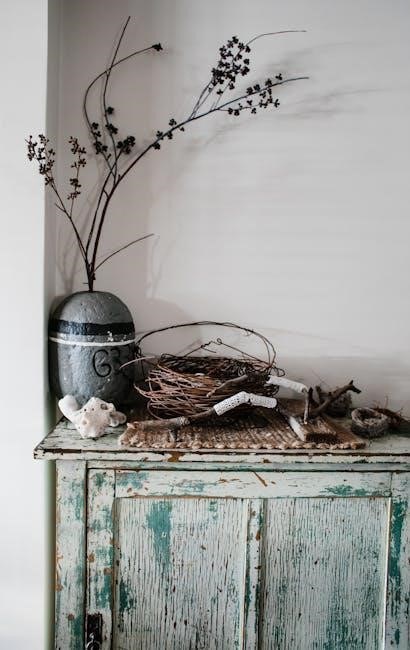
Resources for Learning More About Living with Art
Explore recommended books like Several books are highly recommended for understanding the integration of art into daily life. Destination Cl & C2: Grammar and Vocabulary provides advanced insights, while Wittgenstein and Communication Technology offers philosophical perspectives. Real Users and Real Needs is a study on user queries, offering practical insights. These texts, along with online courses, help deepen your appreciation of art’s role in living spaces and provide practical advice for selecting and displaying art effectively. They are invaluable resources for anyone looking to enhance their understanding of art and its impact on interior design and personal well-being. Online courses and tutorials offer a wealth of knowledge on living with art, providing practical insights and creative strategies. Platforms like Coursera and Skillshare feature courses on art appreciation, interior design, and the psychology of color. Tutorials often cover topics such as selecting art that complements your space and understanding the emotional impact of color schemes. These resources are ideal for both beginners and enthusiasts, offering flexible learning opportunities to enhance your understanding of art’s role in creating meaningful living environments. They empower you to make informed decisions when integrating art into your home, fostering a deeper connection with the spaces you inhabit. Living with art enriches your life, touching emotions and inspiring personal growth. Embrace art daily to create meaningful spaces and foster a lasting connection with beauty. Art leaves an indelible mark on your life, inspiring personal growth and emotional well-being. It fosters a deeper connection to cultural narratives and enhances your surroundings, creating meaningful spaces. Through its ability to evoke emotions and spark reflection, art becomes a lifelong companion, shaping your identity and legacy. By embracing art, you cultivate a sense of purpose and belonging, transforming your home into a reflection of your soul. The lasting impact of art lies in its power to inspire, heal, and connect, making it an essential part of a fulfilling and enriching life. Embracing art in your daily life enriches your experiences and fosters creativity. Start small by exploring local galleries, experimenting with DIY projects, or simply appreciating the beauty in everyday objects; Art is a powerful tool for personal expression and can transform mundane routines into meaningful moments. Whether through collecting pieces, engaging in creative activities, or mindful observation, incorporating art into your life leads to a more vibrant and fulfilling existence. By embracing art, you open yourself to new perspectives, emotional healing, and a deeper connection to the world around you, making each day an opportunity for inspiration and growth.13.1 Recommended Books on Art and Living
13.2 Online Courses and Tutorials
14.1 The Lasting Impact of Art in Your Life
14.2 Encouragement to Embrace Art in Your Daily Life
